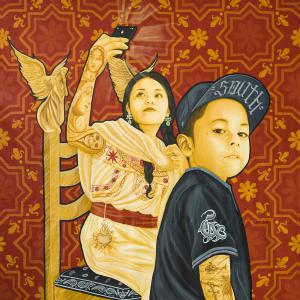
The Museum Of Latin American Art Presents OaxaCAlifornia
Originally created as part of the exhibition known as, For the Pride of Your Hometown, the Way of the Elders, and in Memory of the Forgotten (2016-2017), the murals made their debut in 2017 at the Los Angeles Public Library. They were featured in the exhibition, Visualizing Language: Oaxaca in L.A., as part of the Pacific Standard Time: LA/LA initiative.
“MOLAA is committed to presenting exhibitions that cultivate a cultural exchange and dialogue on both a national and international level,” said Lourdes I. Ramos-Rivas, Ph.D., President & CEO of MOLAA.
The murals explore the intersections of language and culture as a key lifeline – sustaining the shared experience between Los Angeles and Mexico, and beyond. By focusing on exploring the history and underrepresentation of indigenous peoples, the murals address how migration and the socio-political environment shape identity and cultural traditions.
“The message of our murals is simple. Wherever you are, you must know where you come from, be aware of the identity of which you descend and always dignify it,” said the artists.
Their creative process is closely related to the communication that exists between Mexico and the United States, taking from this exchange different expressions that occur from unofficial cultural contexts, as well as the experiences and analysis that give them the coming and going of people and ideologies.
The exhibition demonstrates the Museum’s commitment to providing a programming of excellence that is diverse and inclusive, where all mediums of Latin American and Latin art are represented.
“The Museum of Latin American Art (MOLAA) is proud to present this great work of life stories and experiences of cultural exchange from the hands of the artistic duo, Tlacolulokos,” said Gabriela Urtiaga, Chief Curator at MOLAA. “Culture, history, and migration, from south to north and from north to south, are the central axis in this series of large-scale paintings.”
The murals are now part of the MOLAA Permanent Collection and will continue to be available to the public at the Museum as part of an exhibition to showcase their relevance within the context of Latinx communities in California. A comprehensive and dynamic interpretive program that expands on the symbols used in each mural will accompany the exhibition.
OaxaCAlifornia will be on view to the public March 1 through December of 2020. The Museum of Latin American Art is located at 628 Alamitos Ave. in Long Beach. MOLAA is open Wednesday through Sunday with general admission priced at $10. For more information, visit MOLAA’s website at www.molaa.org or call (562) 437-1689.
###
Exhibition: Oaxacalifornia: Through The Experience Of The Duo Tlacolulokos
On View: March 1, 2020 – December 2020
Artist(s): Tlacolulokos | Dario Canul (b. 1986) and Cosijoesa Cernas (b. 1992)
Museum of Latin American Art 628 Alamitos Ave., Long Beach, CA 90802
Hours: Wednesday, Friday through Sunday: 11:00am – 5:00pm Thursday: 11:00am - 9:00pm
Admission: $10.00 General/ $7.00 Students (w/ID) and seniors (65+) Members & kids under 12 Free
Free Admission every Sunday offered by MOLAA
Info: (562) 437-1689 or www.molaa.org
About the Museum of Latin American Art (MOLAA)
The Museum of Latin American Art (MOLAA) is the only Museum in the United States fully dedicated to modern and contemporary Latin American and Latino art. Founded in 1996 by Robert Gumbiner, MOLAA houses a collection of more than 1,600 works of art including paintings, sculptures, drawings, mixed-media, photographs, and video art. The Museum is a multidisciplinary institution committed to providing a platform for cross-cultural dialogue through the arts, educational programs and events for the community.
About Tlacolulokos
Dario Canul (b. 1986) and Cosijoesa Cernas (b. 1992) form the collective Tlacolulokos. Both artists are from the town of Tlacolula, Oaxaca, Mexico, a Zapotec community located in the Central Valley region of the state, and an important center of Zapotec culture.
Tlacolulokos work with a variety of graphic techniques and media such as video, audio, prints, photography, and painting. Their work is figurative and combines different styles such as street art, easel and mural painting, and screen printing. Their work takes place in the streets and in artistic spaces. Through their work, Tlacolulokos offer a reflection of local reality, and the struggles and problems of their place of origin.
Alexa Ortega-Mendoza
Museum of Latin American Art
+ +1 5622164109
email us here
Visit us on social media:
Facebook
Twitter
LinkedIn
Distribution channels: Culture, Society & Lifestyle, World & Regional
Legal Disclaimer:
EIN Presswire provides this news content "as is" without warranty of any kind. We do not accept any responsibility or liability for the accuracy, content, images, videos, licenses, completeness, legality, or reliability of the information contained in this article. If you have any complaints or copyright issues related to this article, kindly contact the author above.
Submit your press release
